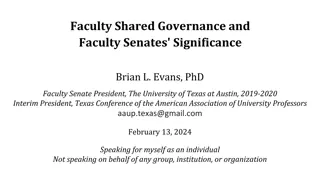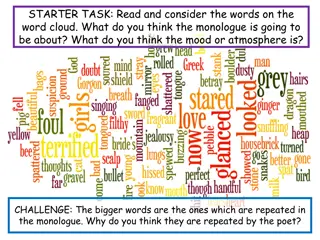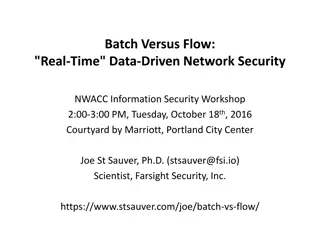
Microsoft's Parallel Computing Platform and Research Initiative
Discover Microsoft's Parallel Computing Platform within their broader research initiative, aiming to enable parallel computing for Windows developers and drive the shift to ubiquitous parallelism. Learn about the impact of manycore architectures on application development and the challenges of transferring research to product development.
Download Presentation

Please find below an Image/Link to download the presentation.
The content on the website is provided AS IS for your information and personal use only. It may not be sold, licensed, or shared on other websites without obtaining consent from the author. If you encounter any issues during the download, it is possible that the publisher has removed the file from their server.
You are allowed to download the files provided on this website for personal or commercial use, subject to the condition that they are used lawfully. All files are the property of their respective owners.
The content on the website is provided AS IS for your information and personal use only. It may not be sold, licensed, or shared on other websites without obtaining consent from the author.
E N D
Presentation Transcript
Microsoft Research Faculty Summit 2008
Microsoft's Parallel Computing Platform Applied Research in a Product Setting Joe Duffy Lead Software Development Engineer Parallel Computing Platform (Visual Studio)
What is the Parallel Computing Platform? Part of Microsoft s Parallel Computing Initiative Microsoft s Parallel Computing Initiative encompasses the vision, strategy, and innovative technologies for delivering transformative, natural, and immersive personal computing experiences, that harness the computing power of manycore architectures. What we re trying to do: Enable parallel computing for Windows developers (C++, .NET) Drive shift to ubiquitous parallelism Why? To cope with the hardware reality ahead To enable immersive, rich user experiences Reinvigorate the client
Manycore impacts the entire stack Constructing Parallel Applications Applications Libraries Languages, Compilers and Tools Executing Fine-Grain Parallel Applications Concurrency Runtime Coordinating System Resources and Services OS/Hypervisor Hardware
Change is hard Visual Studio has shipped 9 major versions C++: C Runtime Library (version 9), Win32 1.0 in 1993 .NET Framework (version 3.5) 1.0 in 2001 Lots of legacy , i.e. code already written Win32: >100,000 methods .NET: >10,000 types; >100,000 methods Even more customer code Compatibility is paramount Cultural: Never break a customer app during upgrade Hard to be revolutionary Incubation is a good way to ignore legacy (for a while) Thisis a big reason it s so hard to tech transfer!
Transferring research to product Incubate Research Productize Integrate incubation results into real products Speak w/ customers Compromise due to legacy Proper QA Reliability, bugfixing, polish, Explore research in a product setting Research mashups Consider legacy Fail early and often: feedback loop w/ research MSR partnerships Universities Academic publications Large team: 1-50+ Medium sized team: 1-10 Small # of researchers (often 1)
Concurrency Runtime (i) Concurrency Runtime Maps logical (tasks) to physical concurrency (OS threads & processors) Data structures mirror hardware topology: packages, nodes, and caches --- to optimize for locality Work stealing task queues User-mode cooperative scheduling of blocked tasks Process-level resource management C++ runtime publicly exposed to community OpenMP, .NET runtime hidden, used by abstractions
Concurrency Runtime (ii) Agents Language Parallel Language Integrated Query Managed Library Native Library C++ Bindings CCR Language Parallel Pattern Library Task Parallel Library Concurrent Data Structures CLR Work-Stealing APIs Asynchronous Agents Thread Pool Managed Native Task Scheduler (Concurrency Runtime) Task Scheduler (Concurrency Runtime) Resource Manager (ConcRT) Windows: OS Threads
Concurrency Runtime (iii) Hard problems Engineering complexity Achieving sufficiently capable but simple architecture Efficiency: static over-expression, dynamic load balance Real-world workloads: what to optimize for? What does the 5-10 year hardware architecture look like? In order? Out of order? SIMD? MIMD? GPU? Memory architecture? Influenced by R. D. Blumofe, C. E. Leiserson. Scheduling multithreaded computations by work stealing. 1994. H. J. Lu. Heterogeneous multithreaded computing. 1995. G. E. Blelloch, P. Gibbons, Y. Matias. Provably efficient scheduling for languages with fine-grained parallelism. 1999.
Task parallelism (i) .NET and C++ offerings Task Parallel Library (.NET) Parallel Pattern Library (C++) Primary features Object-oriented task abstractions Logical lifecycle & well-defined state transitions Parent/child relationships (structured concurrency) First class cancelation Common exceptions story Dataflow (aka, futures) Nonblocking continuations (aka, promises)
Task parallelism (ii) Hard problems Clean & nonobtrusive design Fine-grained efficiency: reducing task footprint Safety with the addition of concurrency Relationship to message passing, nonblocking Influenced by H.C. Baker Jr., C. Hewitt. The Incremental Garbage Collection of Processes. 1977. A.N. Hambermann, I.R. Nassi. Efficient Implementation of Ada Tasks. 1980. J. E. Richardson, M. J. Carey, D. T. Schuh. The Design of the E Programming Language. 1993. A. Rossberg, D. L. Botlan, G. Tack, T. Brunklaus, G. Smolka. Alice ML Through the Looking Glass. 2004.
Imperative data parallelism (i) TPL & PPL Parallel for loops (integer ranges, iterators) Recursion (dynamic limits) Reductions In-place sorts E.g., simple for loop Parallel.For(0, N, i => { }); parallel_for(0, N, [&](int i) { }); E.g., also over .NET enumerables and C++ iterators Parallel.ForEach(e, t => { }); parallel_for_each(e->begin(), e->end(), [&](T * t) { });
Imperative data parallelism (ii) Hard problems Balance between static & dynamic scheduling Load imbalance Integration into an existing side-effectful ecosystem Lots of good research: too much, in fact Influenced by L. Lamport. The parallel execution of DO loops. 1974. W. D. Hillis, G. L. Steele, Jr. Data parallel algorithms. 1986. C. D. Polychronopoulos, D. J. Kuck. Guided self-scheduling: A practical scheme for parallel supercomputers. 1987. W. D. Hillis. The connection machine. 1989.
Declarative data parallelism (i) PLINQ == Parallel (P) LINQ-to-Objects (LINQ) Visual Studio 2008 introduced LINQ SQL-like operators to unify DB, in-memory, and XML data access Can query across multiple data source: join XML w/ in-memory, etc. C# & VB have language syntax PLINQ auto-parallelizes in-memory and XML parts E.g., filter, project, sort int[] arr = some big array ; var q = from x in arr where p(x) // p: predicate/filter orderby k(x) // k: key selection routine select f(x); // f: data transformation float[] out = q.ToArray(); // Execute!
Declarative data parallelism (ii) Hard problems Loss of control => perceived efficiency New way of expressing problems Nonfunctional problems don t map well: graphics, etc. Expectations about order (e.g., queries over arrays) Heuristics: how parallel to go? Decision criteria? Influenced by D.J. DeWitt, R.H. Gerber, G. Graefe, M.L. Heytens, et. al. GAMMA: a high performance dataflow database machine. 1986. G. E. Blelloch. NESL: A nested data-parallel language. 1995. G. Graefe. Volcano: An extensible and parallel query evaluation system. 1994. D. Tarditi, S. Puri, J. Oglesby. Accelerator: Using data parallelism to program GPUs for general-purpose uses. 2006. M.M. T. Chakravarty. R. Leshchinskiy, S.P. Jones. Data parallel Haskell: a status report. 2007.
Scalable containers (i) Communication in shared-memory often container- oriented Currently ad-hoc, race-prone, not scalable, In both .NET and C++ we offer new containers Primary goal is scalability, not theoretical (lock-free) In some cases, we use lock-free to improve reliability Combination of non-blocking and fine-grained locking Stack, queue, deque, linked list, hashtable, set, Some coordination-oriented: blocking & bounding Managed equivalents to .NET containers C++ are STL-like
Scalable containers (ii) Hard problems Pushing the right abstractions Expected semantic parity w/ sequential collections Enumeration/iteration Synchronization approach Performance of CAS on current generation hardware (~100-500 cycles) ABA in C++ Influenced by M. M. Michael, M. L. Scott. Simple, fast, and practical non-blocking and blocking concurrent queue algorithms. 1996. T. Harris. A pragmatic implementation of non-blocking linked lists. 2001. M. M. Michael. High-performance dynamic lock-free hash tables and list- based sets. 2002. M. M. Michael. Hazard pointers: Safe memory reclamation for lock-free objects. 2004. M. M. Michael. ABA prevention using single-word instructions. 2004.
Memory models Memory models are a constant signal Large amounts of lock-free code Written to abstract memory models .NET 2.0: stronger than JMM (but harder to implement) C++: weak, exposes underlying hardware MM Hard problems Resisting the temptation to use too much (intellectually stimulating) Pushing the edge here we ve found code-gen bugs Influenced by L. Lamport. Time, clocks, and the ordering of events in a distributed system. 1978. L. Lamport. How to make a multiprocessor computer that correctly executes multiprocess programs. 1979. M. P. Herlihy, J. M. Wing. Linearizability:A correctness condition for concurrent objects. 1990. J. Manson, B. Pugh. The Java memory model. 2004, 2005.
Verification All of this lock-free and concurrency oriented code It s hard enough to write But even harder to verify its correctness Hard problems Area of active new research: impossible to keep up Lack of programming model support (contracts) Brute force testing is costly (time & hardware matrix) Influenced by Y. Yu, T. Rodeheffer, W. Chen. RaceTrack: Efficient detection of data race conditions via adaptive tracking. 2005. M. Musuvathi, S. Qadeer. CHESS: Systematic stress testing of concurrent software. 2007. S. Burckhardt. Memory model sensitive analysis of concurrent data types. 2007.
Transactional memory TM C# syntax & CLR JIT compiler support Many approaches: optimistic write-in-place, buffered writes, ... Hard problems Existing ecosystem: extension points, I/O Strong vs. weak atomicity Atomicity safety: publication, privatization Efficiency Keeping up with the research community Influenced by Herlihy, Moss. Transactional memory: Architectural support for lock-free data structures. 1993. T. Harris, K. Fraser. Language support for lightweight transactions. 2003. M.F. Spear, V.J. Marathe, L. Dalessandro, M.L. Scott. Privatization techniques for software transactional memory. 2007. C.C. Minh, M. Trautmann, J.W. Chung, A. McDonald, et. al. An effective hybrid transactional memory system with strong isolation guarantees. 2007.
Asynchronous agents Orchestration language Coarse-grained agent-based concurrency Loosely coupled with contracts All interactions across isolation boundaries via message passing channel ChSum { input int [] Add; output int Sum; Start: { Add -> Computing; -> End; } Computing: { Sum -> Start; } } agent A : ChSum { A() { while (true) { int [] in = receive(this::Add); this::Sum <- SumArray(in); } } } agent B : ChSum { B() { this::Add => SumArray => this::Sum } } Influenced by G Andrews, R Olsson: The SR Programming Language, 1993 ISO 8652 (a.k.a. Ada) C A R Hoare: Communicating Sequential Processes, 1978 M F ndrich, M Aiken, C Hawblitzel, O Hodson, G Hunt, J Larus, S Levi: Language Support for Fast and Reliable Message-based Communication in Singularity OS, 2006
Statically provable thread safety Many constructs provided lead to traps int c = 0; Parallel.ForEach(0, N, i => c++); Functional languages help: think Haskell (all side-effects are monads) Hence purity & immutability as 1st class constructs can help But Win32, .NET, and our customers are very imperative Instead: integrated isolation support in the type system Hard problems Legacy! Lack of unified research Influenced by J. M. Lucassen, D. K. Gifford. Polymorphic effect systems. 1988. J. Hughes. Why functional programming matters. 1989. P. Wadler. Linear types can change the world! 1990. M. Abadi, C. Flanagan, S.N. Freund. Types for safe locking: Static race detection for Java. 2006. M. Barnett, K.R.M. Leino, W. Schulte. The Spec# programming system: An overview. 2004.
Parting thoughts; and a challenge We are paying attention A big part of our job is mining & aggregating research Applying it in a product setting often entails (surprisingly a lot) more than the research suggests (legacy) We ve taken the first few steps down a long road Starting with mechanisms (ship) Exploring encompassing programming models (incubate) A challenge A significant portion of customers don t have CS degrees Even those that do have a big concurrency learning curve How can we get them to write parallel code? We ll be looking to you for help in the coming years
Thank-you http://msdn.microsoft.com/concurrency/ joedu@microsoft.com






















